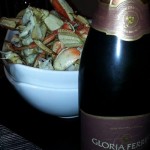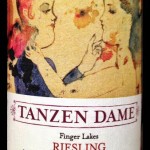Here is a sampling of what our editors and contributors have been drinking…
Bryan Calandrelli, Niagara Editor: Ravine Vineyard 2010 Reserve Cabernet Franc Picone Vineyard
With overwhelming reviews from across the border and a few labels of “best cabernet franc” at a few wine competitions, I bit the bullet and threw down $50 for this single vineyard wine. Sourced from Chef Mark Picone’s vineyard in the Vinemount Ridge Appellation of Ontario (an area at the top of the escarpment where cooler temps and higher acidity usually prevails) this wine combines a warm vintage, major league vineyard management and the very capable cellar team at Ravine Vineyard to produce a cab franc with the ability to wow.
It’s full of black fruits and spices in a frame that is both plush and firm. I drank this 2010 a bit earlier than I should’ve but I suppose it’s better than drinking too late. With a bit of heat it may not be indicative of a typical vintage here, but it certainly resembles the profile of some of the best cab francs produced on the USA side of the escarpment in fruit profile and tannic structure albeit with more finesse. More evidence that terroir doesn’t have a nationality.
 Jim Silver, Business Editor: Gloria Ferrer NV Blanc de Noirs
Jim Silver, Business Editor: Gloria Ferrer NV Blanc de Noirs
We’re setting up the Christmas tree this evening so I thought to pop a bottle of something new and local (for me), the Stone Brewery Enjoy By 12.13.13 IPA. Sorry guys, I guess I just don’t get the modern IPA trend. This beer tastes a lot like chewing on my new six foot high Noble Fir’s needles and bark. It’s so resiny and piney as to be off putting, but not so out of bounds that I won’t finish it. But at 9.5% alc I think I’ll need a nap.
Really the story here is the Gloria Ferrer Blanc de Noirs with Dungeness crabs from last night. I’m not terribly familiar with this species of hard-shelled crab, but apparently here in Sonoma it’s in season. It’s got a beautifully ocean-y smell with a mild flavor, and meaty legs, but the body (the lump part) is fabulously lump-y, plump and delicious.
The local sparkler, derived of pinot, and from a well-known house is a sub-$20 joy. Fat and fruity, with zesty strawberry, cranberry and dried cherry flavors, wrapped up in a pink-ish package. It is long in the mouth and very clean in the finish. Honestly, I’m not sure I’ve had much better at this price point. It makes me want to try the Blanc de Blancs as well and see if I can find a racier, more aperitif-style sparkler from my new neighborhood.
Todd Trzaskos: Maestria de Main de Maitre 2010
Been digging on the Sud-Ouest de France wines for a couple of years now. It’s not an area well known for its fine wine production, but I have been finding more wines of intriguing quality and approachable pricing. The vines of southwest France have been growing since the Romans, well ahead of Bordeaux. The Bordelaise, once their shipping center was established in the middle-ages, squeezed their southern neighbors whose wine mostly floated downstream towards their port via the Dordogne and Gironde. With access to trade limited, and the northern neighbors also using the better stuff from the south west to ‘enhance’ their own lesser vintages, and expand their branded production, it’s no wonder that it is still a “lesser known” region. The wines of Madiran are from even further south, and do not have the same proximity to the rivers that would direct them to Bordeaux. Bayonne is the closer port, but not one that served the wine industry in the same way, and as such, was not a channel for world recognition.
This is important, because timing is everything, and South France is on the verge of a ‘NOW’ moment. While the Argentines currently own Malbec and many are blind to its origin in Cahors, the Uraguayan wine biz is hoping to gain a reputation for fine Tannat, before folks remember that Madiran has been there, and is still doing that. Tannat, the most tannic of wines, often taking years or decades to soften in the bottle. I’ve been fortunate to try a handful of nice Chateau produced tannat varietals, in youth and with some age. In each case they have been striking. Like a sandy punch in the mouth when young, and because of their sheer blue density with time.
This bottle was a different beast, and as I subsequently found out, intentionally so. A cooperative based wine, described as “A new style of Madiran to be drunk young to fully appreciate its fruit”. (Read: Micro-oxygenation) Priced around $17 and on sale for $11. Fairly reserved nose of purple earthy dark tones but not revealing much more than a hint of cocoa. All it’s info is on the tongue. Reads a cool freshness at outset even at room temp. Aggressive grippy fruit tannins present mid palate and ride for a very long time. Mid-density and tight, with a sense that it is still stitching. Three layers of wine, not quite finding harmony, but feeling the potential to do so. The top layer a light fruit driven black raspberry berry cassis, a second grittier and dark broad stroke covering the tongue as if a paintbrush, and finally an oak regime that is sometimes spicy accoutrements and other time pokes out as woody. 70% Tannat 30% cab sauvignon. Could use a helping of roast meat, or hearty stew with winter vegetables.
Lindsay Prichard, Finger Lakes Correspondent: Bell’s Brewery Two Hearted Ale
Before national beer distribution became as prevalent as it is today, regional breweries struggled to gain recognition outside their immediate geographic area. A popular theme that many employed to establish a memorable identity was nature and the outdoors. For the male-dominated beer drinking population, it was an effective approach. Whether there was an actual connection between the beer and nature was somewhat secondary in importance. Breweries like Schmidt, Hamm’s, Genesee, Coors and others featured label art and advertising slogans to connect their beer to the great outdoors. Despite changing demographics among beer drinkers, it’s still a popular (and somewhat nostalgic) theme in beer advertisting today.
My son recently introduced me to some new craft beer including Two Hearted Ale from Bell’s Brewery. When I saw the trout on the bottle’s label, I immediately thought of the Schmidt Beer can from the 1970s that featured a jumping Northern Pike as part of their Outdoor Life series. As cool as those cans were, the similarities stopped there. Schmidt was a watery, flavorless lager that was more attractive for the can than it was for the beer inside.
Bell’s Two Hearted Ale is an American IPA that has a great balance of hops and malt. The taste is so clean that it actually seems like something that could have come from an icy, outdoor stream. And it’s not without flavor. It has both muted sweet and bitter flavors, and very pleasant pine and citrus notes. It’s easy drinking and refreshing and stands out from the crowd without resorting to gimmicks.
Bell’s Brewery started out as a homebrewing company, but is quickly establishing itself as a producer of high quality beer. Without a doubt, their Two Hearted Ale is one of my new favorites.
 Michael Chelus, Niagara-Erie Correspondent: Bloomer Creek Vineyard 2011 Tanzen Dame Riesling, Morehouse Road Vineyard - 1st Harvest
Michael Chelus, Niagara-Erie Correspondent: Bloomer Creek Vineyard 2011 Tanzen Dame Riesling, Morehouse Road Vineyard - 1st Harvest
Given my wife’s growing affinity for the variety, we’ve been making a concerted effort to explore different New York State rieslings.We’ve had some great experiences trying new ones and rediscovering ones we’d enjoyed in the past. This wine fits the description of the former.
The wine had a gorgeous light straw color in the glass. There was bright Bartlett pear and ripe apricot on the nose. Pear and Granny Smith apple were dominant on the palate. There was a well-balanced acidity complimented by a modest residual sugar content. The balance struck between the two was well done. The underlying minerality makes the wine intriguing and makes you thirst for more.
This one went over well on Thanksgiving with not only my wife, but also with our family and friends. I’m looking forward to discovering the rest of the Tanzen Dame series from Bloomer Creek.
